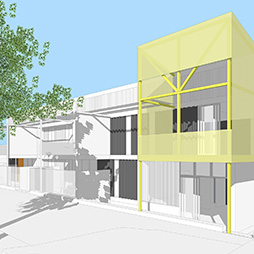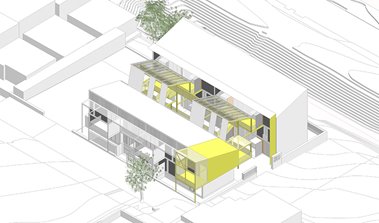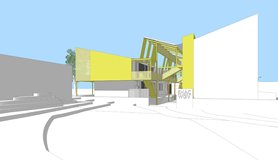 Building SHAC
Building SHAC
Words by Koral Ward
I’m standing on a bare piece of ground in White Gum Valley, on the corner of Nannine and Hope Streets, facing west. It used to be the site of the Kim Beazley School. The Fremantle Men’s Shed is just over to the right (for the time being anyway), and to the left there is a sump which has had water catchment tanks sunk into it and will be landscaped by Josh Byrne to form a delightful park.
This point marks both a culmination and a new departure. Building is about to begin and new ground is being broken literally and metaphorically. Dwellings are to be built for Fremantle artists to live and work in. The artists are members of the co-operative, Sustainable Housing for Artists and Creatives (SHAC). The organisation aims to be as sustainable a development as possible in terms of its impact on the environment, the place and the people it involves. Sustainability in this instance refers to the ability of artists to sustain themselves, their practice and their families, and to contribute to the social good of the wider community. It also refers to sustaining the artistic heritage and creative identity of Fremantle.
The artists of SHAC are varied - photographer, object collector/makers, fashion designer, sculptors, printmakers, musicians, poets and writers, and performers. Many are involved in cultural development and work to bring the benefits of the arts to the community in all its diversity.
Artists have traditionally lived and worked in Fremantle, and Fremantle is very proud of this fact. SHAC’s intention is to continue the tradition of Fremantle as a city that nurtures its artistic and creative community, making it possible for artists and creatives to remain living and working here and contributing to this place. Over the years, rapidly rising property prices and a crisis in affordable rental space have had an impact on Fremantle’s art community with many leaving the area to find more affordable housing, living and working conditions.
The original members of SHAC came together in a house on Stevens Street, White Gum Valley, which had been artists’ housing for at least 15 years. Karen Hethey, a founding member, says, “The house had traditionally been kept in artists’ circles as it was inexpensive and could enable artists to build their practice and could (also) be used as a community resource for storage and projects – which it was on many occasions.”
With a view to keeping the Stevens Street property as a resource for the community, the group that became SHAC raised substantial funds toward buying it but, not surprisingly, fell short of the market value of the site. The group investigated partnerships with arts bodies and other co-ops in the area and approached housing bodies involved in housing affordability projects. Then, just as Stevens Street was in imminent danger of being lost, there came a fortuitous meeting with ACCESS Housing, an affordable housing provider based in Fremantle. This led to SHAC signing a Memorandum of Understanding (MOU) with ACCESS in December 2014 to construct affordable dwellings within LandCorp's new White Gum Valley residential estate.
 One year later the development received international endorsement as a One Planet Community, making it only the 11th project in the world to receive this recognition, setting new standards for sustainable development in Western Australia.
One year later the development received international endorsement as a One Planet Community, making it only the 11th project in the world to receive this recognition, setting new standards for sustainable development in Western Australia.
Since signing the MOU, SHAC has worked closely with ACCESS Housing, moving through the process of appointing architects (Donaldson and Warn) and working with them to realise the group’s aspirations for the development. Over 2015, SHAC progressed from an excited design brainstorming session in which pens, paper, dreams and desires were spread over the floor of the Town Hall, through to the dawning reality of actual needs and concrete possibilities, to eventual negotiation of an achievable middle ground. It’s been a fascinating and informative process for us all and what has eventuated is a design for medium density living that provides dwellings and work space that balances private and public needs, and the intentions of the SHAC members.
The build will comprise 12 dwellings and a substantial studio block of two stories, the upper with individual workspaces for rent by co-op members (whether they live there or not). The ground floor studio space is the building block that underpins the economic sustainability of SHAC. It will lend itself to use for big projects, rehearsal space, events, classes, exhibitions for local (non-SHAC) artists and international visiting artists. It will reach out to the immediate community, to networks of fellow creative people, to the arts institutions, and it will bring creative ‘goods’ to the wider community. This space is intended as a community creative hub and we will be trying to raise finance to purchase it from ACCESS Housing to make sure it stays in the public domain.
SHAC will also be tendering for and engaging in public art projects to generate funds. In fact we have already won a commission for a public artwork in Waikiki Park (the plunging fish designed by SHAC member Fiona Gavino). For the landscape architect Josh Byrne working on the White Gum Valley site, we have provided designs for a street print, bike racks, and interpretive signage.
SHAC is extremely grateful for ACCESS Housing’s foresight and bravery in taking on this innovative model of building affordable housing. It has been done by working directly with an already formed community of people and building to their needs, rather than building first and then filling the development with disparate people who must somehow form a community. ACCESS has forged a new approach to making community in Fremantle and their hard work in combining affordable housing budget restraints with the beautiful contemporary design of Donaldson and Warn, has produced a landmark structure of which Fremantle can be proud. The design skillfully fits a variety of home sizes, from single dwellings to two and three bedroom family or share-house sized, on a small block.
 Embarking on the next phase of the project, the MOU between SHAC and ACCESS will become a legal Project Agreement lasting for 10 years from when we move in (projected to be early 2017). The challenge is to negotiate the legal and financial implications and responsibilities of the project so that SHAC can flourish and sustain its presence as a community asset when the 10 year agreement with ACCESS is over. Building and strengthening the social capital to do this is a process that requires resources, so raising funds will be an important task. So too will be the reliable, stable relationships among people and institutions required to ensure that the public good created cannot easily be appropriated for a private few but can enhance the effectiveness and efficiency of the collective and individuals now and into the future. So in this way, they are sustainable.
Embarking on the next phase of the project, the MOU between SHAC and ACCESS will become a legal Project Agreement lasting for 10 years from when we move in (projected to be early 2017). The challenge is to negotiate the legal and financial implications and responsibilities of the project so that SHAC can flourish and sustain its presence as a community asset when the 10 year agreement with ACCESS is over. Building and strengthening the social capital to do this is a process that requires resources, so raising funds will be an important task. So too will be the reliable, stable relationships among people and institutions required to ensure that the public good created cannot easily be appropriated for a private few but can enhance the effectiveness and efficiency of the collective and individuals now and into the future. So in this way, they are sustainable.
Although we are breaking new ground as a group, what we are doing is based on a traditional model, the co-operative, with its underlying ethos that profits produced go back into the organisation before individual members benefit. It may actually surprise some people to know how strong the co-operative movement is, how economically sound co-operatives can be, and how many co-operatives there are here in Western Australia – and not just for housing. The principle is mutuality. SHAC still has some original members from the Stevens Street days, which is significant when considering that such long-term initiatives run on the enthusiasm of individuals. Some have fallen away - it takes a lot of stamina and belief to stick with a long-term project based on a dream. There are many meetings and duties that require learning how to do the things we are doing, as we are doing them.
SHAC welcomes new members who would like to contribute their efforts to this endeavour, as champions and supporters of our cause, to keep the resource in the hands of the community and not to lose it to the prevailing market forces. You might consider becoming a member, or a sponsor, or simply a friend – which you can do easily by visiting our Facebook page! Also look out for a SHAC crowd-funding venture to help us gain equity in the SHAC Studio – it’s coming soon!
I shift from the glare of the open space to the shade of one of the few remaining trees on the site, which makes it a significant tree. It stands above the sump and to the side of the SHAC site. Here we are, balanced between empty space and impending structure. What follows will be the formation of place. This time next year SHAC will be welcoming you at a gathering beneath the shade of this tree, in celebration of the opening of this new place for artists dwelling within the community.
In the meantime, follow the SHAC journey on our Facebook page!
